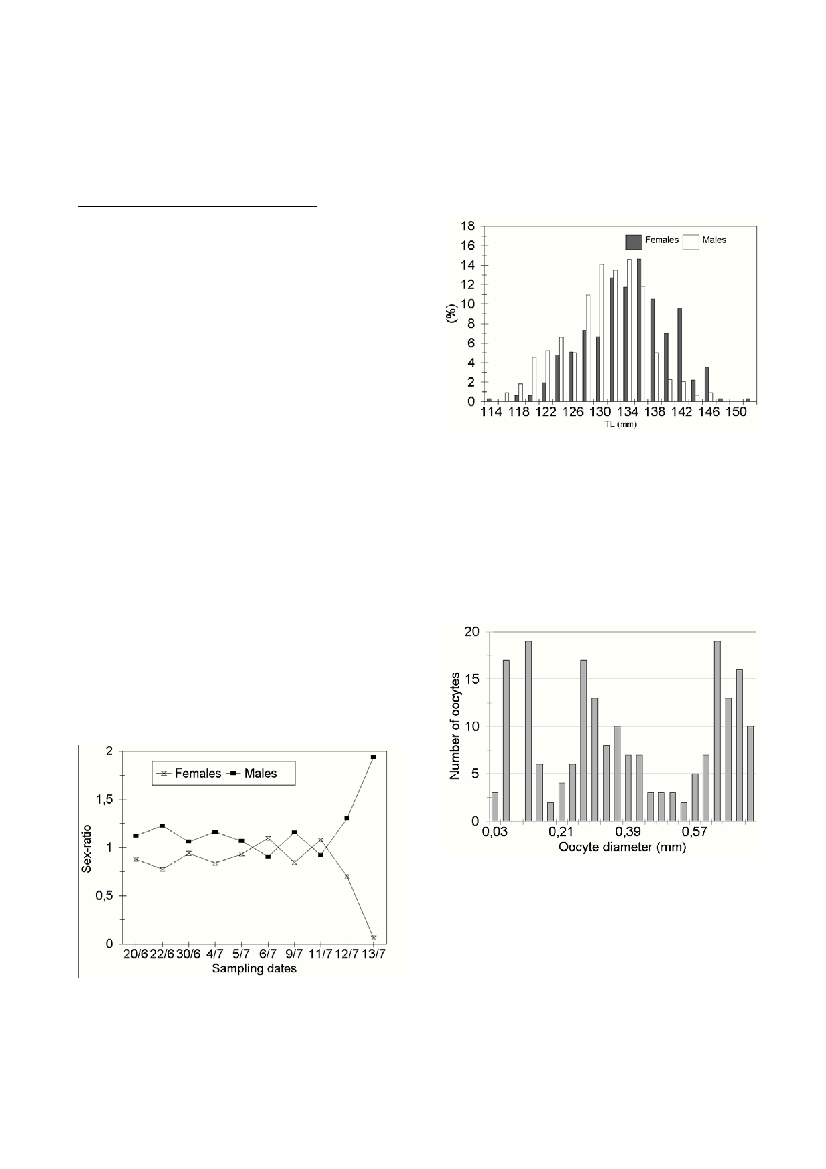Rapp. Comm. int. Mer Médit., 36,2001
334
Mediterranean anchovy along with sardine constitute the bulk of
pelagic catches. The Aegean Sea anchovy catches rank first, and con-
tribute to the combined Mediterranean catches by 36%. Although up
to 1987 anchovy catches presented an ascending trend, recent fishery
data indicated that the production of anchovy is now following a
declining trend. In fact, this decreasing trend is obvious in the whole
Mediterranean, and coupled with a parallel increase of the fishing
effort, suggests possibly a problem of over-fishing.
The present study provides preliminary data on the sexual maturity,
the sex-ratio and the fecundity of the Mediterranean anchovy in the
Thracean Sea, contributing to the better knowledge of the species
reproduction in this area, which is considered among the most impor-
tant anchovy fishing grounds in Greek waters.
In June and July 1999, samples of adult anchovies were collected
from commercial vessels (purse-seines), as well as by using a hired
vessel, fishing outside the commercial fishing grounds, but inside the
study area. Immediately after their collection, and in order to prevent
deterioration of the ovaries, the abdominal cavity of adult specimens
was opened and they were preserved in 10% formalin solution. During
sample analysis, the total weight (W; nearest 0,1g), gutted weight
(EW; nearest 0,1g), total length (LT; cm, nearest 1mm), gonad weight
(GW; nearest 0,1g) and maturity stage according to the Holden & Raitt
scale (1) were recorded. Batch fecundity was evaluated by counting
oocytes belonging to the largest modal size group, present in the
ovaries of 11 females.
Our data revealed that during the sampling period, spawning activ-
ities of anchovies were in progress since the 71.5% of the males and
the 65.3% of the females were in the IIIrd and IVth maturity stage of
the Holden & Raitt scale (1). The gonads of the 20% of the males and
the 21.7% of females were at a spent condition. The considerably lim-
ited presence of virgin specimens (stage I) should be underlined,
re?ecting the absence of young anchovies (<110 mm TL) from our
samples, mainly due to gear selectivity.
Regarding sex-ratio, males dominated till 134 mm TL, while in the
length interval 134-138 mm the sex-ratio did not differ significantly
from the theoretical 1:1 value. In larger specimens, however, females
outnumber males, dominating completely beyond 146 mm. Males
were more numerous than females in all samplings, except : during the
end of the spawning season, when females dominated (Fig. 1). One-
way analysis of variance indicated significant differences between the
mean lengths of males and females (F=68.35, P<0.001).
Figure 1. Sex-ratio of the Thracean Sea anchovy in June-July 1999.
Figure 2. Length frequency distribution of the anchovy collected in the
Thracean Sea in June and July 1999.
The study of the length frequency distribution of the anchovies col-
lected in the Thracean Sea revealed that the bulk of the males was
comprised between 126 and 136 mm TL, while the majority of the
females was between 130 and 144 mm TL. The fact that females
reached bigger sizes than males was also mentioned for the anchovy
of the Adriatic (2).
Since no hydrated oocytes were found in the samples, fecundity
was estimated by counting the largest and most advanced oocy
t
e
s
(Fig. 3). Batch fecundity of the Thracean Sea anchovy appeared to
range between 2704 and 9.239 oocytes, values that do not seem to dif-
fer significantly from those mentioned for the anchovy of west
Mediterranean (3).
Figure 3. Distribution of the oocyte diameters (maximum dimension)
found in the ovary of a 136 mm female anchovy collected in the
Thracean Sea in June 1999.
References
1. Holden M. J. and Raitt D. F. S., 1974. Manual of fisheries science. Part 2.
FAO Fish. TECH.Pap. 115 (Rev.1) : 241pp.
2. Casavola, N., Marano G., Saracino C. and De Martino L., 1981.
Osservazioni sulla pesca e ciclo riproduttivo dei Clupeiformi nel Basso
Adriatico : Engraulis encrasicholus(L.),Oebalia.,7 : 27-42. :
3. Palomera I and Pertierra J. P., 1993. Anchovy biomass estimate by the daily
egg production method in 1990 in the western Mediterranean.Sci. Mar., 57(2-
PRELIMINARY DATA ON THE REPRODUCTION OF MEDITERRANEAN ANCHOVY IN GREEK WATERS
V.Vassilopoulou*, E. Caragitsou and A. Anastasopoulou
National Centre for Marine Research, Hellinikon, Athens, Greece
Abstract
In the Thracean Sea, gonadal maturity of the Mediterranean anchovy peaks in early summer. Size of specimens ranged between 110 and
155 mm TL, males dominating among smaller fish, while females were encountered more frequently in large size groups. Anchovy batch
fecundity was estimated by counting oocytes of the largest modal size present in the ovary and was found to range between 2704 and 9.239
oocytes.
Keywords : Teleostei, reproduction, Aegean Sea

